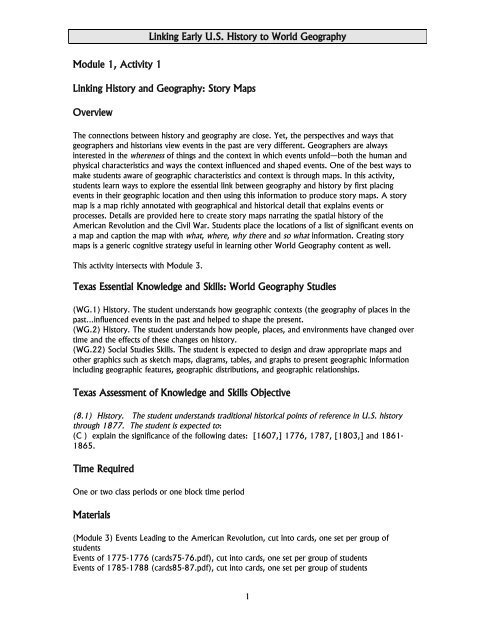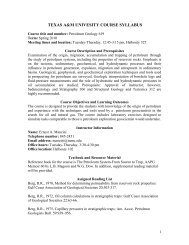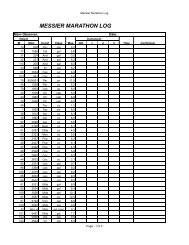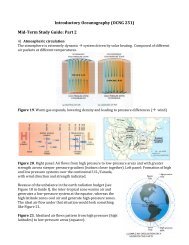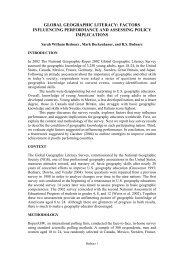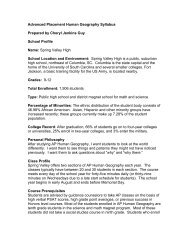Linking Early U.S. History to World Geography Module 1, Activity 1 ...
Linking Early U.S. History to World Geography Module 1, Activity 1 ...
Linking Early U.S. History to World Geography Module 1, Activity 1 ...
You also want an ePaper? Increase the reach of your titles
YUMPU automatically turns print PDFs into web optimized ePapers that Google loves.
<strong>Module</strong> 1, <strong>Activity</strong> 1<br />
<strong>Linking</strong> <strong>Early</strong> U.S. <strong>His<strong>to</strong>ry</strong> <strong>to</strong> <strong>World</strong> <strong>Geography</strong><br />
<strong>Linking</strong> <strong>His<strong>to</strong>ry</strong> and <strong>Geography</strong>: S<strong>to</strong>ry Maps<br />
Overview<br />
The connections between his<strong>to</strong>ry and geography are close. Yet, the perspectives and ways that<br />
geographers and his<strong>to</strong>rians view events in the past are very different. Geographers are always<br />
interested in the whereness of things and the context in which events unfold—both the human and<br />
physical characteristics and ways the context influenced and shaped events. One of the best ways <strong>to</strong><br />
make students aware of geographic characteristics and context is through maps. In this activity,<br />
students learn ways <strong>to</strong> explore the essential link between geography and his<strong>to</strong>ry by first placing<br />
events in their geographic location and then using this information <strong>to</strong> produce s<strong>to</strong>ry maps. A s<strong>to</strong>ry<br />
map is a map richly annotated with geographical and his<strong>to</strong>rical detail that explains events or<br />
processes. Details are provided here <strong>to</strong> create s<strong>to</strong>ry maps narrating the spatial his<strong>to</strong>ry of the<br />
American Revolution and the Civil War. Students place the locations of a list of significant events on<br />
a map and caption the map with what, where, why there and so what information. Creating s<strong>to</strong>ry<br />
maps is a generic cognitive strategy useful in learning other <strong>World</strong> <strong>Geography</strong> content as well.<br />
This activity intersects with <strong>Module</strong> 3.<br />
Texas Essential Knowledge and Skills: <strong>World</strong> <strong>Geography</strong> Studies<br />
(WG.1) <strong>His<strong>to</strong>ry</strong>. The student understands how geographic contexts (the geography of places in the<br />
past…influenced events in the past and helped <strong>to</strong> shape the present.<br />
(WG.2) <strong>His<strong>to</strong>ry</strong>. The student understands how people, places, and environments have changed over<br />
time and the effects of these changes on his<strong>to</strong>ry.<br />
(WG.22) Social Studies Skills. The student is expected <strong>to</strong> design and draw appropriate maps and<br />
other graphics such as sketch maps, diagrams, tables, and graphs <strong>to</strong> present geographic information<br />
including geographic features, geographic distributions, and geographic relationships.<br />
Texas Assessment of Knowledge and Skills Objective<br />
(8.1) <strong>His<strong>to</strong>ry</strong>. The student understands traditional his<strong>to</strong>rical points of reference in U.S. his<strong>to</strong>ry<br />
through 1877. The student is expected <strong>to</strong>:<br />
(C ) explain the significance of the following dates: [1607,] 1776, 1787, [1803,] and 1861-<br />
1865.<br />
Time Required<br />
One or two class periods or one block time period<br />
Materials<br />
(<strong>Module</strong> 3) Events Leading <strong>to</strong> the American Revolution, cut in<strong>to</strong> cards, one set per group of<br />
students<br />
Events of 1775-1776 (cards75-76.pdf), cut in<strong>to</strong> cards, one set per group of students<br />
Events of 1785-1788 (cards85-87.pdf), cut in<strong>to</strong> cards, one set per group of students<br />
1
<strong>Linking</strong> <strong>Early</strong> U.S. <strong>His<strong>to</strong>ry</strong> <strong>to</strong> <strong>World</strong> <strong>Geography</strong><br />
Events of the 1861-1865 (cards61-65.pdf), cut in<strong>to</strong> strips, one set per group of students<br />
Student Work Log, one per student<br />
Blank outline maps of the Thirteen Colonies, one for each student<br />
Blank outline maps of the United States, one for each student<br />
Sample s<strong>to</strong>ry maps on overhead transparencies (optional)<br />
Master Lists: Events of 1775-1776 (master75-76.pdf), Events of 1785-1788 (master85-88.pdf),<br />
and Events of 1861-1865 (master61-65.pdf) for teacher reference<br />
Content Preview<br />
Depending upon the time period you wish <strong>to</strong> work with, introduce the activity <strong>to</strong> students in the<br />
context of learning about his<strong>to</strong>rical events from a geographic perspective. Students should<br />
understand these three statements:<br />
• It is impossible <strong>to</strong> understand the present without understanding geography.<br />
• It is impossible <strong>to</strong> understand the present without understanding the past.<br />
• It is impossible <strong>to</strong> understand the past without understanding geography.<br />
In other words, the rationale for his<strong>to</strong>ry (studying the past <strong>to</strong> understand the present) requires<br />
knowing geography: <strong>to</strong>day’s geography and the geography of places in the past. This activity focuses<br />
on location but other activities in this series include details related <strong>to</strong> human and environmental<br />
characteristics of locations, human-environmental relations and spatial organization, all of which play<br />
a role in understanding the geography of the past.<br />
A s<strong>to</strong>ry map is a special kind of map; a blend between a map and a s<strong>to</strong>ry. Key events are put in<strong>to</strong><br />
spatial context, with annotations (labels, brief statements) and graphics (arrows, dotted lines,<br />
symbols) that provide narration. Three examples of s<strong>to</strong>ry maps are included in this activity. Each is<br />
different but all tell a s<strong>to</strong>ry through a map. You may wish <strong>to</strong> make transparencies of these <strong>to</strong> show<br />
students as they develop their own.<br />
Classroom Procedures<br />
Beginning the <strong>Activity</strong><br />
1. Distribute the appropriate timeline cards, one set each <strong>to</strong> a small group of students and Student<br />
Work Logs. If you prefer students may work individually throughout the activity but <strong>to</strong> begin small<br />
groups (two or three students) makes sense.<br />
2. Ask students <strong>to</strong> do two things with the cards: A. read each card and make sure they understand<br />
all terms and concepts; B. put the cards in<strong>to</strong> chronological order. You may wish <strong>to</strong> refer <strong>to</strong> the<br />
master lists as students review events.<br />
3. Have students briefly review the sequence of events by asking questions like “What happened<br />
first? Then what happened?” You may wish <strong>to</strong> ask students <strong>to</strong> write a brief summary on their Log.<br />
Developing the <strong>Activity</strong><br />
4. Next, ask students <strong>to</strong> sort the cards by location. Once again, review the sequence of events, this<br />
time asking questions like “Where did that take place? Why do you think this happened there? Can<br />
2
<strong>Linking</strong> <strong>Early</strong> U.S. <strong>His<strong>to</strong>ry</strong> <strong>to</strong> <strong>World</strong> <strong>Geography</strong><br />
you see connections between locations? Or are some events peculiar <strong>to</strong> that one location? Which<br />
locations seemed most active? When? Why?” Student may organize their thoughts on the Log.<br />
5. Once you are satisfied students have a rough understanding of the events, ask students <strong>to</strong> select<br />
what they perceive as the ten (number can vary) key events from the list and prepare a brief written<br />
statement justifying their choice on the Log.<br />
6. Distribute blank outline maps at the appropriate scale and ask students <strong>to</strong> make a s<strong>to</strong>ry map with<br />
their key events. You might wish <strong>to</strong> have students work individually at this point. Review with<br />
students the key components of a s<strong>to</strong>ry map—key events are put in<strong>to</strong> spatial context, with<br />
annotations (labels, brief statements) and graphics (arrows, dotted lines, symbols) that tell the s<strong>to</strong>ry.<br />
Students might wish <strong>to</strong> keep these four questions in mind as they annotate the map: what, where,<br />
why there and so what? Three examples of s<strong>to</strong>ry maps are included in this activity. Each is different<br />
but all tell a s<strong>to</strong>ry through a map. Students should include all key map components (title, date,<br />
author, legend explaining symbols).<br />
Concluding the <strong>Activity</strong><br />
7. Once students have completed the maps, display them and have students do a “gallery walk.”<br />
You may wish <strong>to</strong> give students small post-its <strong>to</strong> make comments on different maps or provide a<br />
rubric for them <strong>to</strong> evaluate maps. Criteria for the rubric should focus on how well each map tells a<br />
s<strong>to</strong>ry and how well each map narrates the geographic perspective which is a key component of the<br />
events.<br />
Content Background<br />
The background <strong>to</strong> the events leading up <strong>to</strong> the Declaration of Independence and beginning of the<br />
American Revolution (1775-1776), the process of developing the US Constitution (1785-1788)<br />
and the events of the US Civil War (1861-1865) are explained in the Master Lists part of this<br />
activity.<br />
References<br />
American Civil War.com http://americancivilwar.com/<br />
The <strong>His<strong>to</strong>ry</strong> Place http://www.his<strong>to</strong>ryplace.com<br />
3
Sample S<strong>to</strong>ry Maps<br />
<strong>Linking</strong> <strong>Early</strong> U.S. <strong>His<strong>to</strong>ry</strong> <strong>to</strong> <strong>World</strong> <strong>Geography</strong><br />
4
Sample S<strong>to</strong>ry Maps<br />
<strong>Linking</strong> <strong>Early</strong> U.S. <strong>His<strong>to</strong>ry</strong> <strong>to</strong> <strong>World</strong> <strong>Geography</strong><br />
5
Sample S<strong>to</strong>ry Maps<br />
<strong>Linking</strong> <strong>Early</strong> U.S. <strong>His<strong>to</strong>ry</strong> <strong>to</strong> <strong>World</strong> <strong>Geography</strong><br />
6
<strong>Linking</strong> <strong>Early</strong> U.S. <strong>His<strong>to</strong>ry</strong> <strong>to</strong> <strong>World</strong> <strong>Geography</strong><br />
Student Work Log: <strong>Linking</strong> <strong>His<strong>to</strong>ry</strong> and <strong>Geography</strong>: S<strong>to</strong>ry Maps<br />
Introduction<br />
<strong>His<strong>to</strong>ry</strong> and geography are closely linked. It is important <strong>to</strong> know not only WHEN events <strong>to</strong>ok place<br />
in the past but WHERE and WHY THERE. Details here will help you <strong>to</strong> learn more about the events<br />
in a specific period of time in a geographic context. Follow your teacher’s instructions and complete<br />
these tasks.<br />
1. Carefully read the cards your teacher gives you. What terms/concepts do you not understand?<br />
Keep a list of new vocabulary on the back of this Log. Discuss and define the terms until you have a<br />
clear understanding of the events.<br />
2. Next, place the cards in chronological order.<br />
3. Review the sequence of events and write a summary of them here. Be brief. Think about the<br />
events as a s<strong>to</strong>ry you might tell someone and write it in that fashion. Share your s<strong>to</strong>ry with a fellow<br />
student when you have finished it.<br />
4. Sort the events by location. Consider the categories you might wish <strong>to</strong> use—By city? By state? By<br />
region?<br />
5. Again, review the sequence of events you constructed in #3 and re-write your s<strong>to</strong>ry with the<br />
locations included.<br />
7
6. Reflect and answer these questions:<br />
<strong>Linking</strong> <strong>Early</strong> U.S. <strong>His<strong>to</strong>ry</strong> <strong>to</strong> <strong>World</strong> <strong>Geography</strong><br />
• Which locations seemed most active? When? Why?<br />
• Can you observe any connections between locations or were some events peculiar <strong>to</strong> one location?<br />
7. Pick 10 key events from the list and list them here:<br />
1.<br />
2.<br />
3.<br />
4.<br />
5.<br />
6.<br />
7.<br />
8.<br />
9.<br />
10.<br />
Why are these the most important events?<br />
8. Make a s<strong>to</strong>ry map featuring your key events. In a s<strong>to</strong>ry map, key events are put in<strong>to</strong> spatial<br />
context, with annotations (labels, brief statements) and graphics (arrows, dotted lines, symbols) that<br />
tell the s<strong>to</strong>ry. As you design and annotate your map, keep these four questions in mind: what,<br />
where, why there and so what? Remember, you want <strong>to</strong> tell a s<strong>to</strong>ry.<br />
8
The 13 British Colonies<br />
km 0<br />
mi 0<br />
Education Place: http://www.eduplace.com<br />
N<br />
W E<br />
S<br />
200 400<br />
200 400<br />
Copyright (c) Hough<strong>to</strong>n Mifflin Company. All Rights Reserved.
85°W<br />
Lake Superior<br />
Lake Michigan<br />
Lake Huron<br />
Gulf of<br />
Mexico<br />
Colonial America, 1776<br />
80°W 75°W 70°W 65°W<br />
Lake Erie<br />
LEGEND<br />
Proclamation Line of 1763<br />
Colonial boundaries in 1776<br />
City<br />
0<br />
125 miles<br />
0 125 kilometers<br />
Lake Ontario<br />
Education Place: http://www.eduplace.com<br />
N<br />
ATLANTIC<br />
OCEAN<br />
W E<br />
S<br />
45°N<br />
40°N<br />
35°N<br />
30°N<br />
25°N<br />
Copyright (c) Hough<strong>to</strong>n Mifflin Company. All Rights Reserved.
125°W<br />
PACIFIC<br />
OCEAN<br />
120°W<br />
115°W<br />
110°W<br />
105°W<br />
100°W<br />
95°W<br />
90°W<br />
85°W<br />
Lake Superior<br />
Lake Michigan<br />
Lake Huron<br />
80°W 75°W 70°W<br />
Lake Erie<br />
Lake Ontario<br />
Reserved.<br />
Rights All Company.<br />
ATLANTIC<br />
OCEAN<br />
Mifflin Hough<strong>to</strong>n (c)<br />
LEGEND Copyright<br />
Cities with population greater<br />
than 50,000 in 1860<br />
National capital<br />
0 125 250 miles<br />
0 125 250 kilometers<br />
The United States in 1860<br />
Education Place: http://www.eduplace.com<br />
Gulf of<br />
Mexico<br />
Tropic of Cancer<br />
N<br />
W E<br />
S<br />
45°N<br />
40°N<br />
35°N<br />
30°N<br />
25°N


